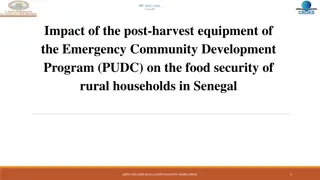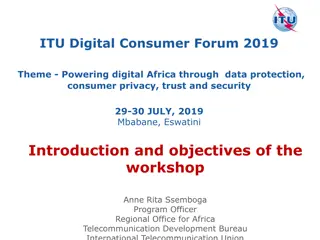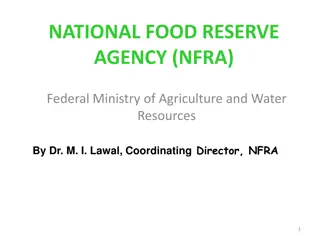Leveraging Digital Technology to Improve Agricultural Output and Food Security in Africa
In Africa, the challenge of food insecurity and malnutrition persists due to insufficient agricultural output and a poorly structured food environment. By embracing digital solutions, such as mobile technology and ICT-based innovations, the continent can enhance food systems, empower farmers, and work towards achieving the Sustainable Development Goals. The increasing adoption of digital tools is aiding in expanding access to information, market connections, and advisory services, ultimately contributing to a more resilient and sustainable food system for Africa's population.
Download Presentation

Please find below an Image/Link to download the presentation.
The content on the website is provided AS IS for your information and personal use only. It may not be sold, licensed, or shared on other websites without obtaining consent from the author. Download presentation by click this link. If you encounter any issues during the download, it is possible that the publisher has removed the file from their server.
E N D
Presentation Transcript
Digital technology to boost agricultural output, improve the food environment and reduce malnutrition in Africa Dr Susan Keino, Moi University susankeino@gmail.com
Introduction In 2019 the food situation was worse in Africa The SDGs adopted in 2015 Global - 821million Africa - 277million A poorly structured food environment, compounded by insufficient agricultural output has led to food insecurity and rise in the number of malnourished people Over the years several strategies have been adopted in a bid to find solutions to rising food insecurity and reduce the triple burden of malnutrition SAP, MDGs and SDGS To achieve SDGS, improving performance of food system is central
More than half of people living in Africa depend on agriculture for all or part of their livelihood The number is high in some parts of Africa (70%) Biteye, 2016. Ending poverty and hunger by 2030 can only be achieved by making the food system more robust, sustainable and resilient By transforming it from a major contributor to climate change into part of the solution World Bank identifies the need to expand digital opportunities to everyone including farmers and agribusiness, as a away to improve food systems and achieving the SDGs (World Bank 2019)
Coverage of digital solutions. In 2017 the number of mobile-phone connections were 747 million in Africa (75% penetration rate); In some parts its 100% Evolving mobile technology has given rise to start-ups aimed at improving income through agribusiness ensuring food availability and accessibility In 2018, there were about 390 registered digital solutions - from 41 in 2012 33 million small holder farmers and pastoralists or about 13% registered on a mobile service for weather updates etc.
Digital technology for agriculture and food security in Africa Techno-health ICT-based solution to enhance early detection, timely reporting and prompt response to health events in human and animal population in Africa In Sub Saharan Africa small holder farmers and pastoralists, estimated 33 million people already registered with mobile phone-based service for weather updates, market connections In Ethiopia, free 80-28 hotline is a farmer advisory service has been instrumental in aligning services to local circumstances Kerimuribo et. al 2019.
In Ghana Farmaline and AgroCenta use mobile and web technologies to disseminate farmer advice,- weather forecasts, market information and financial tips to farmers who are traditionally out of reach due to connectively Kenya Agricultural Observatory Platform developed by KALRO It provides real-time and historical records of relevant weather variables including short-term weather forecasts by county farmers can plan and start planting on time to avoid losses Farmdrive a Kenyan enterprise, connects unbanked and underserved smallholder farmers to credit, while helping financial institutions cost- effectively increase their agricultural loan portfolios.
Ujuzikilimo also in Kenya uses big data to bring farmers together in a knowledge-based community (Ekekwe, 2017) GeoFarmer tested in Ghana and Tanzania provide near real-time, two-way data flows that can be used to monitor agricultural production systems, with interactive feedback between users. M-pesa in Kenya developed by Safaricom and Vodafone allows traders, farmers and consumers to transfer money and pay for services and goods M-shwari a service provided by m-pesa is a microfinance facility allowing farmers to access credit and pay back with minimal interest. Kilimo salama scheme (safe agriculture) provides crop insurance to farmers using mpesa Sokohewani ( market in the air ), sokoshambani aimed at linking farmers to market and other services (Ehui, 2018) SokoShambani @SokoShambani Meeting of farmers and buyers
How can digital technologies improve food environment and reduce malnutrition in Africa? Digital technology need to improve production of nutritious crops for dietary diversity Nutritious foods need to be available, accessible, affordable and acceptable (4As) Direct nutrition interventions need to be scaled up Eg. m-HEALTH, Improving nutrition outcomes requires building capacity of nutrition specialists across Africa The Nutrition Society founded the eNutrition Academy (eNA) Facilitates shared learning and build capacity e-library of evidence for nutrition action (eLENA) List of nutrition interventions to help countries implement and scale up
Conclusion Digital solutions for agriculture are important if Africa is to feed itself in 2050 Several digital start-ups and innovations have demonstrated a measurable impact in improving this need to be quantified Digital technology can also help; close the gender gap in agriculture Attract youth back to farming Increase in agricultural production alone will not lead to better food environment and reduce malnutrition unless specific focus on nutritional outcomes is built into agri-food related technologies Scale up direct nutrition interventions























